

Flying Dragon
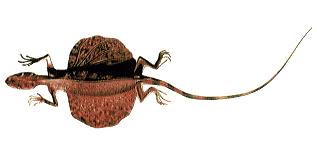
Scientific Name: Draco volans
Size: body: 19-22 cm
Habitat: rainforest, rubber plantations
Conservation Status: Non-threatened

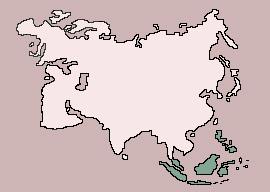 A arboreal lizard, the so-called flying dragon actually glides from tree to tree
on winglike skin flaps. At each side of its body, between front and hind limbs,
there is a large flap of skin, supported by extended movable ribs. Usually these
flaps are held folded at the sides of the body, but they can be extended to
carry the lizard in an almost horizontal glide for many meters. The flying
dragon feeds on insects, particularly ants. To breed, the flying dragon descends
to the ground and buries its 1 to 4 eggs in the soil.
A arboreal lizard, the so-called flying dragon actually glides from tree to tree
on winglike skin flaps. At each side of its body, between front and hind limbs,
there is a large flap of skin, supported by extended movable ribs. Usually these
flaps are held folded at the sides of the body, but they can be extended to
carry the lizard in an almost horizontal glide for many meters. The flying
dragon feeds on insects, particularly ants. To breed, the flying dragon descends
to the ground and buries its 1 to 4 eggs in the soil.
Indian Cobra
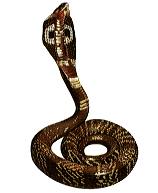
Scientific Name: Naja naja
Size: body: 1.8-2.2 m
Habitat: rainforest, rice fields, cultivated land
Conservation Status: Non-threatened
ˇ@
ˇ@
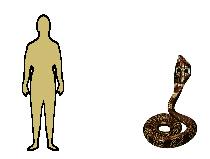
 A large, highly venomous snake, the Indian cobra feeds on rodents, lizards and
frogs. As well as biting, the Indian cobra can attack or defend itself from a
distance by "spitting" venom, which, if it enters the opponent's eyes,
causes severe pain and damage. The snake actually forces the venom through its
fangs, by exerting muscular pressure on the venom glands, so that it sprays out
in twin jets for 2 m (6 1/2 ft) or more. In its characteristic threat posture,
the Indian cobra raises the front one-third of its body and spreads out its
long, flexible neck ribs and loose skin to form a disklike hood, on the back of
which there are markings resembling eyes. Indian cobras pay more attention to
their eggs than is usual in snakes. The 8 to 45 eggs (usually 12 to 20) are laid
in a hollow tree, a termite mound or earth into which the snakes tunnel. The
female guards the clutch throughout the incubation period, leaving them only for
a short time each day to feed. The young hatch after about 50 or 60 days.
A large, highly venomous snake, the Indian cobra feeds on rodents, lizards and
frogs. As well as biting, the Indian cobra can attack or defend itself from a
distance by "spitting" venom, which, if it enters the opponent's eyes,
causes severe pain and damage. The snake actually forces the venom through its
fangs, by exerting muscular pressure on the venom glands, so that it sprays out
in twin jets for 2 m (6 1/2 ft) or more. In its characteristic threat posture,
the Indian cobra raises the front one-third of its body and spreads out its
long, flexible neck ribs and loose skin to form a disklike hood, on the back of
which there are markings resembling eyes. Indian cobras pay more attention to
their eggs than is usual in snakes. The 8 to 45 eggs (usually 12 to 20) are laid
in a hollow tree, a termite mound or earth into which the snakes tunnel. The
female guards the clutch throughout the incubation period, leaving them only for
a short time each day to feed. The young hatch after about 50 or 60 days.
Vine Snake

Scientific Name: Oxybelis fulgidus
Size: body: 1.5-2 m
Habitat: rainforest, cultivated land
Conservation Status: Non-threatened
ˇ@ˇ@
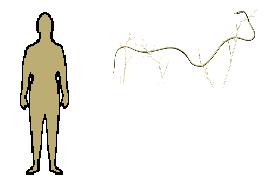
 Barely the thickness of a man's finger, about 1.25 cm (1/2 in) in diameter at the most,
the vine snake is a remarkably slender, elongate species. As it lies amid the
branches of forest trees, its proportions and greeny-brown coloration make it
almost indistinguishable from the abundant creepers and vines. Its head, too, is
thin and elongate and equipped with rear fangs and mild venom. A slow-moving
predator, active in the daytime and at night, the vine snake feeds mainly on
young birds, which it steals from nests, and on lizards. If threatened, it puffs
up the front of its body, revealing vivid coloration usually hidden under
scales, and opens its long mouth wide. A frightened snake may also sway from
side to side, like a stem in the breeze.
Barely the thickness of a man's finger, about 1.25 cm (1/2 in) in diameter at the most,
the vine snake is a remarkably slender, elongate species. As it lies amid the
branches of forest trees, its proportions and greeny-brown coloration make it
almost indistinguishable from the abundant creepers and vines. Its head, too, is
thin and elongate and equipped with rear fangs and mild venom. A slow-moving
predator, active in the daytime and at night, the vine snake feeds mainly on
young birds, which it steals from nests, and on lizards. If threatened, it puffs
up the front of its body, revealing vivid coloration usually hidden under
scales, and opens its long mouth wide. A frightened snake may also sway from
side to side, like a stem in the breeze.
Xenosaurus
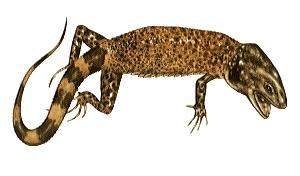
Scientific Name: Xenosaurus sp.
Size: body: about 20 cm
Habitat: rainforest
Conservation Status: Non-threatened
ˇ@
ˇ@
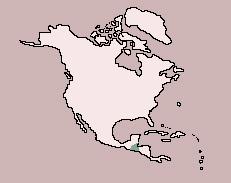 These
powerful, strong-limbed lizards have flat heads and robust bodies. They are
inconspicuous creatures and are not often seen, spending much of their time in
refuges beneath tree roots or in rocky crevices. They will also lie in water for
long periods. Active at night, they feed on insects, particularly winged
termites and ants. If alarmed, Xenosaurus adopts a threat posture, with mouth
agape, revealing a black membrane. The females gives birth to litters of 3 fully
formed live young, which are about 4 cm (1 1/2 in) long at birth.
These
powerful, strong-limbed lizards have flat heads and robust bodies. They are
inconspicuous creatures and are not often seen, spending much of their time in
refuges beneath tree roots or in rocky crevices. They will also lie in water for
long periods. Active at night, they feed on insects, particularly winged
termites and ants. If alarmed, Xenosaurus adopts a threat posture, with mouth
agape, revealing a black membrane. The females gives birth to litters of 3 fully
formed live young, which are about 4 cm (1 1/2 in) long at birth.
Poison Arrow Frog
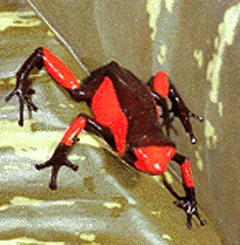
 Poison-arrow frogs are social frogs found in Central and South
America. They are known by their bright colors which warn other animals
that they are poisonous. Their colors vary from
red to yellow to blue. Its poison is one of the most powerful known
and can cause paralysis or death. About 200
different poisonous chemicals have been found so far in the skin of these small
frogs. It is so potent that one millionth of
an ounce can kill a dog and an amount smaller than a grain of salt can
kill a human. One frog carries enough poison to kill about 100 people. Though poison-arrow frogs carry
a deadly poison, they are usually harmless if left alone.
Native hunters use it on the tips of their arrows which is how the frog
got its name. Poison-arrow frogs are about the size of a man's thumbnail (less than
one inch). The tiny frogs lay their eggs under leaves. The parents guard the eggs
until they hatch, then carry the tadpoles on one of their backs where
the parents feed it small insects, ants, spiders, crustaceans, and tiny
water animals. The mother frog may also lay infertile eggs as food for
the tadpoles. The enemies they encounter are large animals
(including humans) who may step on them.
Poison-arrow frogs are social frogs found in Central and South
America. They are known by their bright colors which warn other animals
that they are poisonous. Their colors vary from
red to yellow to blue. Its poison is one of the most powerful known
and can cause paralysis or death. About 200
different poisonous chemicals have been found so far in the skin of these small
frogs. It is so potent that one millionth of
an ounce can kill a dog and an amount smaller than a grain of salt can
kill a human. One frog carries enough poison to kill about 100 people. Though poison-arrow frogs carry
a deadly poison, they are usually harmless if left alone.
Native hunters use it on the tips of their arrows which is how the frog
got its name. Poison-arrow frogs are about the size of a man's thumbnail (less than
one inch). The tiny frogs lay their eggs under leaves. The parents guard the eggs
until they hatch, then carry the tadpoles on one of their backs where
the parents feed it small insects, ants, spiders, crustaceans, and tiny
water animals. The mother frog may also lay infertile eggs as food for
the tadpoles. The enemies they encounter are large animals
(including humans) who may step on them.
Blue Jeans Frog
 This little amphibian has been nicknamed the blue jeans frog. The
skin of this frog contains a powerful toxin used by hunters to poison the
tips of their arrows and blow gun darts. Even in the rain forest the cool animals wear blue jeans.
This little amphibian has been nicknamed the blue jeans frog. The
skin of this frog contains a powerful toxin used by hunters to poison the
tips of their arrows and blow gun darts. Even in the rain forest the cool animals wear blue jeans.
Bromeliad Frog
 Many different kinds of small frogs live in and around the pools provided by the
central cup of tank bromeliads. These frogs mainly eat ants and other small
insects that come to the bromeliad. They reproduce in the bromeliad, and their
tadpoles develop in the water-filled pools, feeding off algae, mosquito larvae,
or other small organisms in the water. Two kinds of bromeliad frogs are marsupial frogs and
the colorful poison arrow frogs. Some marsupial frogs carry their eggs and
developing tadpoles under a skin flap on their back. When the female enters the
water in the bromeliad pool, the tadpoles are released into the water and
continue their development there.
Many different kinds of small frogs live in and around the pools provided by the
central cup of tank bromeliads. These frogs mainly eat ants and other small
insects that come to the bromeliad. They reproduce in the bromeliad, and their
tadpoles develop in the water-filled pools, feeding off algae, mosquito larvae,
or other small organisms in the water. Two kinds of bromeliad frogs are marsupial frogs and
the colorful poison arrow frogs. Some marsupial frogs carry their eggs and
developing tadpoles under a skin flap on their back. When the female enters the
water in the bromeliad pool, the tadpoles are released into the water and
continue their development there.
Saltwater Crocodiles
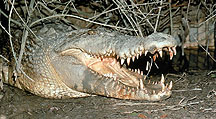 Saltwater crocodiles can grow to more than 20 feet long. They are one of the most aggressive animals on
earth. They've been known to attack canoes out at sea. (Right picture) Northern Australian Salt Water Crocodile.
Saltwater crocodiles can grow to more than 20 feet long. They are one of the most aggressive animals on
earth. They've been known to attack canoes out at sea. (Right picture) Northern Australian Salt Water Crocodile.
Caiman
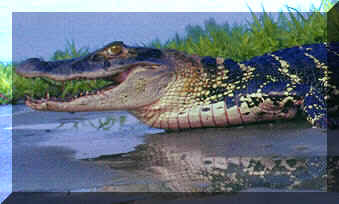
 During a night excursion on the rivers that feed into the Amazon, you suddenly see a red
glow on the waterˇ¦s surface. These are the eyes of a caiman as it searches for a meal. These reptiles are
similar to both the crocodile and the alligator in appearance and behavior., but
are more closely related to alligators. Caiman prefers freshwater, so are found
in rivers.
Those in the Juma River, a tributary of the Mamori and Solimões River ,
measure from around 3 to 6 meters in length.
During a night excursion on the rivers that feed into the Amazon, you suddenly see a red
glow on the waterˇ¦s surface. These are the eyes of a caiman as it searches for a meal. These reptiles are
similar to both the crocodile and the alligator in appearance and behavior., but
are more closely related to alligators. Caiman prefers freshwater, so are found
in rivers.
Those in the Juma River, a tributary of the Mamori and Solimões River ,
measure from around 3 to 6 meters in length.
Emerald Tree Boa
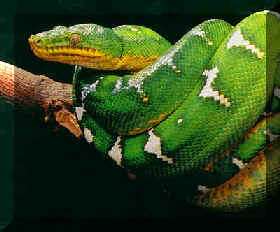
 This beautiful snake lives almost entirely in the
trees. It is well-camouflaged, with green skin striped with white or yellow.
This protective coloration allows the snake to get near its prey without being
seen, and also helps to conceal it from predators like the Harpy eagle.
The boaˇ¦s common hunting strategy is to remain quiet and inconspicuous in the
trees as it waits for potential victims to come close; it then strikes out and
grabs or drops on the prey animal. Boas are non-poisonous constrictors that kill
the prey by squeezing and suffocating. The boaˇ¦s diet usually consists of
small birds, but it also kills small rodents, such as mice or young agoutis,
lizards, other snakes, etc.
This beautiful snake lives almost entirely in the
trees. It is well-camouflaged, with green skin striped with white or yellow.
This protective coloration allows the snake to get near its prey without being
seen, and also helps to conceal it from predators like the Harpy eagle.
The boaˇ¦s common hunting strategy is to remain quiet and inconspicuous in the
trees as it waits for potential victims to come close; it then strikes out and
grabs or drops on the prey animal. Boas are non-poisonous constrictors that kill
the prey by squeezing and suffocating. The boaˇ¦s diet usually consists of
small birds, but it also kills small rodents, such as mice or young agoutis,
lizards, other snakes, etc.